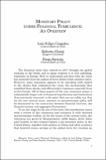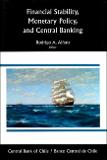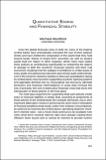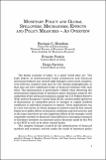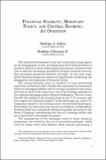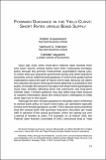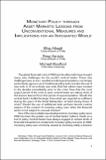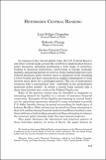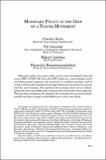Buscar
Mostrando ítems 1-10 de 19
Monetary policy under financial turbulence: an overview
The financial crisis that started in 2007 brought the global economy to the brink and in many respects it is still unfolding especially in Europe. How to understand and deal with the crisis has naturally been the subject of fierce debates that continue today. However some consensus appears to be ...
Monetary policy under financial turbulence
The financial crisis that started in 2007 brought the global economy to the brink, and in many respects it is still unfolding, especially in Europe. While a fierce debate continues on how to understand and deal with the crisis, a consensus is emerging with regard to the originating shocks, the mechanisms ...
Financial stability, monetary policy, and Central Banking
The financial developments of the last decade have had a large impact on the range of risk diversification contracts available to investors. Based on these complex instruments, the investment possibility frontier was shifted outward and increasingly intricate networks were created. At the same time, ...
Quantitative easing and financial stability
Since the global financial crisis of 2008–09 many of the leading central banks have dramatically increased the size of their balance sheets and have shifted the composition of the assets that they hold toward larger shares of longer-term securities (as well as toward assets that are riskier in other ...
Monetary policy and global spillovers: mechanisms effects and policy measures: an overview
The global economy of today 'is a small world after all.' The high degree of international trade integration and financial interconnectedness has created tight linkages across most countries even between countries that may be very distant geographically or that may not have significant trade or financial ...
Financial stability monetary policy and Central Banking: an overview
The financial developments of the last decade had a large impact on the management of risk providing more diversified portfolios to investors. Based on these complex financial contracts investors were able to shift the investment possibilities frontier outward however that movement generated intricate ...
Forward guidance in hte yield curve: short rates versis bond supply
Since late 2008 when short-term interest rates reached their zero lower bound central banks have been conducting monetary policy through two primary instruments: quantitative easing (QE) in which they buy long-term government bonds and other long-term securities and so-called forward guidance in which ...
Monetary policy thorugh asset markets: lessons from unconventional measures and implications for an integrated world
The global financial crisis of 2008 and its aftermath have brought many new challenges for the world’s central banks. These new challenges have in turn resulted in bold experimentation—not simply particularly vigorous use of traditional policy tools but also the use of new tools or if not entirely new ...
Heterodox central banking
In response to the current global crisis the U.S. Federal Reserve and other central banks around the world have implemented diverse policy measures including purchasing a wide range of securities lending to financial institutions intervening in foreign exchange markets and paying interest on reserves. ...
Monetary policy in the grip of a pincer movement
Monetary policy has come under strain since the global financial crisis (GFC) of 2007–09. Once the GFC broke out central banks’ swift and determined response was essential to stabilise markets and to avoid a self-reinforcing downward spiral between the financial system and the real economy. But putting ...


